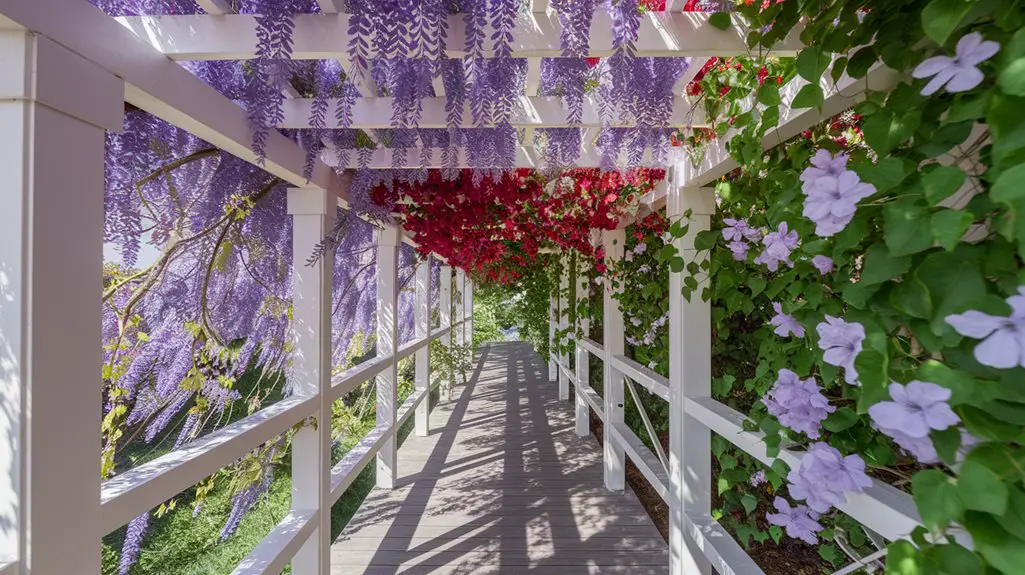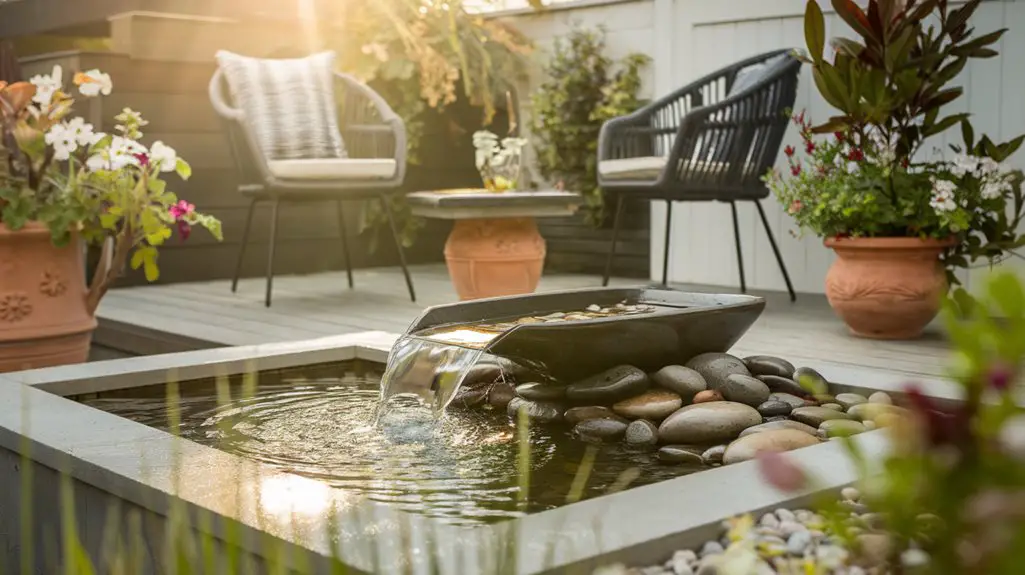Your pergola or gazebo offers the perfect framework for creating a living tapestry of color and fragrance throughout the seasons. When properly selected, flowering climbers transform these architectural elements from mere structural features into vibrant focal points that enhance your entire landscape design. The vertical growing space accommodates a diverse range of plant species with varying bloom times, growth habits, and environmental requirements. By strategically combining complementary varieties, you'll establish a multi-dimensional garden space that evolves with stunning visual interest as the months progress.
Climbing Roses: Elegant Blooms for Vertical Garden Spaces
When selecting vertical accents for garden structures, climbing roses (Rosa spp.) offer unparalleled elegance and versatility for pergolas and gazebos. These robust cultivars produce abundant blooms while their flexible canes can be trained to ascend support columns, arch over crossbeams, and cascade from roof edges.
You'll find several categories worth considering: Ramblers like 'Dorothy Perkins' grow vigorously with smaller clustered flowers; large-flowered climbers such as 'Climbing Peace' produce exhibition-quality blooms; and repeat-flowering varieties including 'New Dawn' provide continuous color throughout the season.
For northern climates, choose cold-hardy options like 'William Baffin' (Zone 3), while heat-tolerant varieties such as 'Don Juan' (Zone 5-9) thrive in southern regions. Additionally, incorporating kid-friendly outdoor seating can enhance the enjoyment of your garden space during playdates.
Install climbing roses in well-drained soil with six hours of direct sunlight to maximize flowering potential.
Wisteria: Cascading Purple Beauty for Overhead Structures
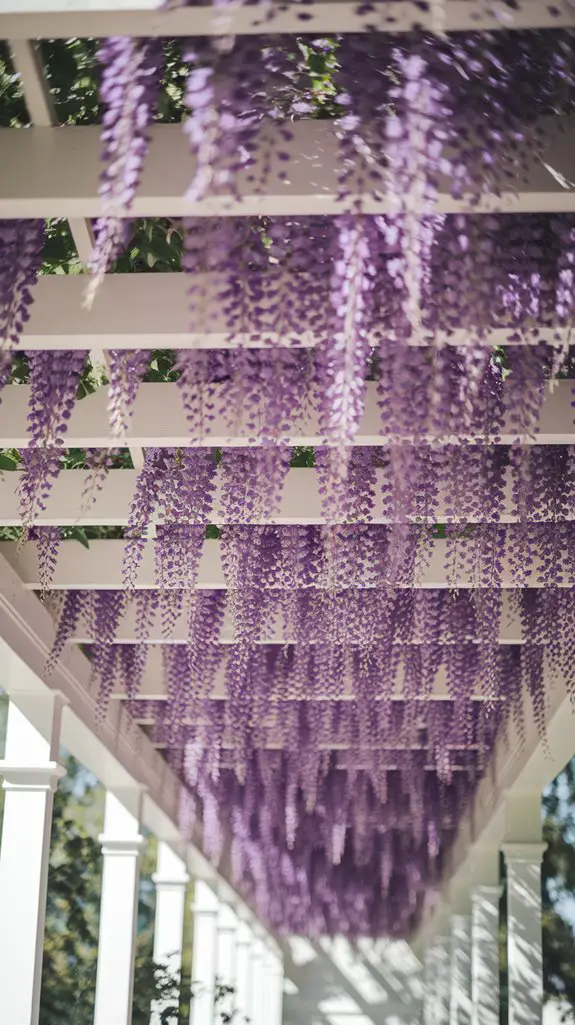
Few flowering vines command the dramatic presence of Wisteria (Wisteria spp.), whose pendulous racemes transform overhead structures into ethereal flowering canopies each spring.
When establishing wisteria on your pergola or gazebo, you'll need to install robust support systems capable of bearing the mature vine's substantial weight—often exceeding 1,000 pounds.
- Chinese wisteria (W. sinensis) develops sweetly fragrant violet-blue clusters up to 12 inches long that bloom before foliage emerges.
- Japanese wisteria (W. floribunda) produces longer racemes (up to 36 inches) with a clockwise twining habit and flowers after leaf development.
- American wisteria (W. frutescens) offers a less aggressive native alternative with 6-inch clusters and more controlled growth patterns.
You'll achieve ideal flowering by planting in full sun positions with well-drained soil and implementing annual late-winter pruning to control growth and stimulate bloom formation. Additionally, incorporating pollinator-friendly plants around your wisteria can enhance the overall biodiversity and attract beneficial insects to your garden.
Clematis Varieties for Year-Round Color
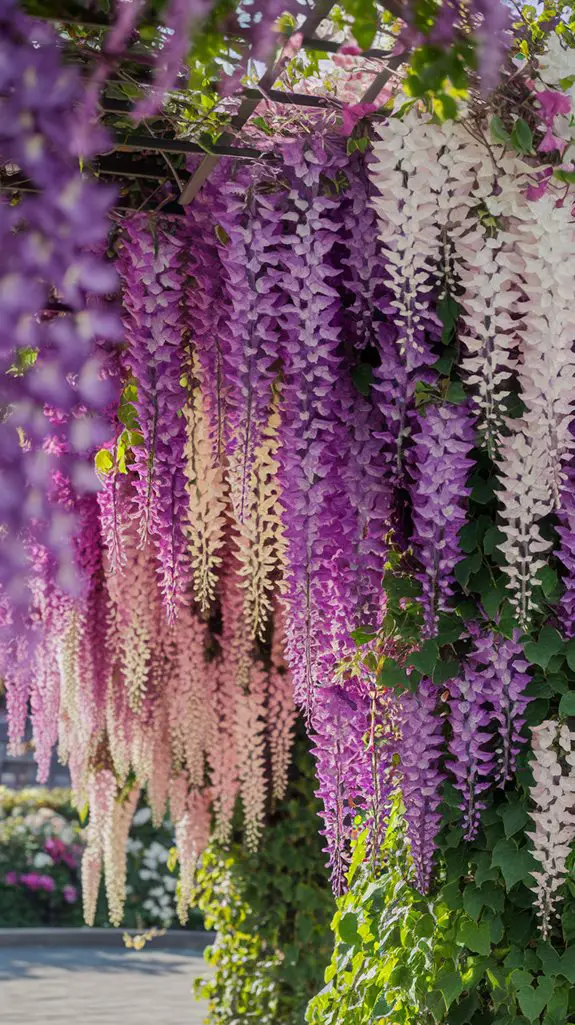
Clematis varieties (Clematis spp.) offer perhaps the most diverse color palette and blooming periods among flowering vines, enabling you to achieve continuous visual interest on your pergola or gazebo throughout the growing season.
Group 1 clematis (like 'Nelly Moser' and 'Miss Bateman') bloom on old wood in spring, while Group 2 types ('Henryi', 'Jackmanii') flower twice—spring on old growth and summer on new shoots.
Group 3 cultivars ('Sweet Autumn', 'Ville de Lyon') bloom exclusively on current year's growth in late summer to fall. By combining these pruning groups, you'll enjoy flowers from April through October.
Position clematis roots in cool, moist soil while training vines to climb sunlit structures. Most varieties prefer 6+ hours of sun but appreciate shaded root zones. Creative landscaping ideas can further enhance the aesthetic appeal of your outdoor spaces.
Supplement climbing with discreet wire supports.
Jasmine: Fragrant White Flowers for Evening Enjoyment
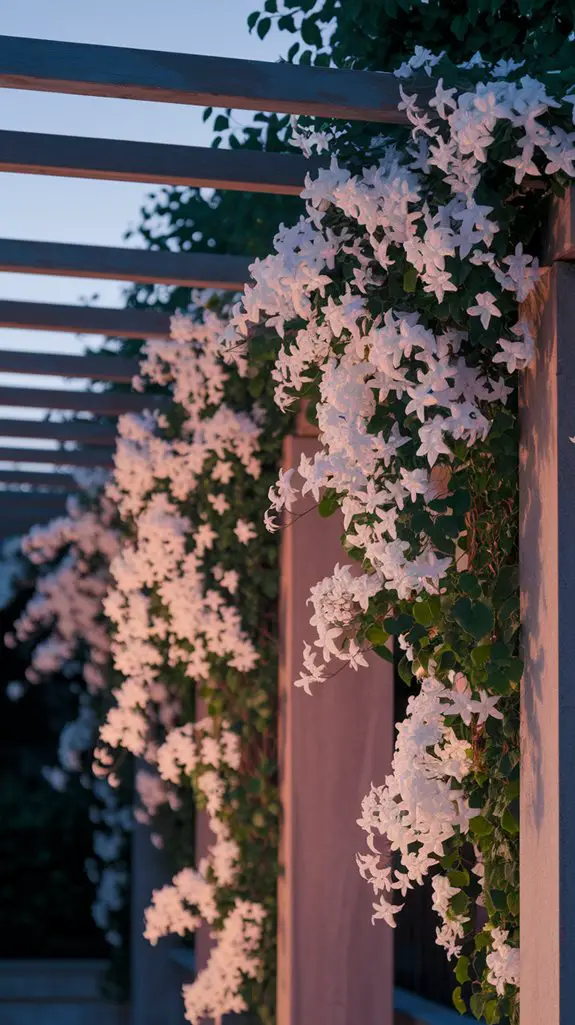
Among the most enchanting additions to any outdoor structure, jasmine (Jasminum spp.) offers intoxicating fragrance that intensifies during evening hours, making it ideal for pergolas and gazebos used for nighttime entertaining.
You'll find several jasmine species suitable for different climates. J. polyanthum thrives in zones 8-10, while the more cold-hardy J. officinale withstands zones 7-10.
Plant jasmine in well-draining soil with partial sun exposure to optimize blooming. Water regularly during establishment, then reduce to weekly irrigation during growing season. Additionally, incorporating native plant landscaping can enhance the overall biodiversity and sustainability of your garden.
- Star jasmine (Trachelospermum jasminoides) produces pinwheel-shaped blooms from spring through summer with glossy evergreen foliage.
- Common jasmine (J. officinale) features pinnate leaves and iconic white flowers that bloom June through August.
- Winter jasmine (J. nudiflorum) delivers yellow blooms during cooler months when other climbers remain dormant.
Bougainvillea: Bold and Drought-Tolerant Coverage
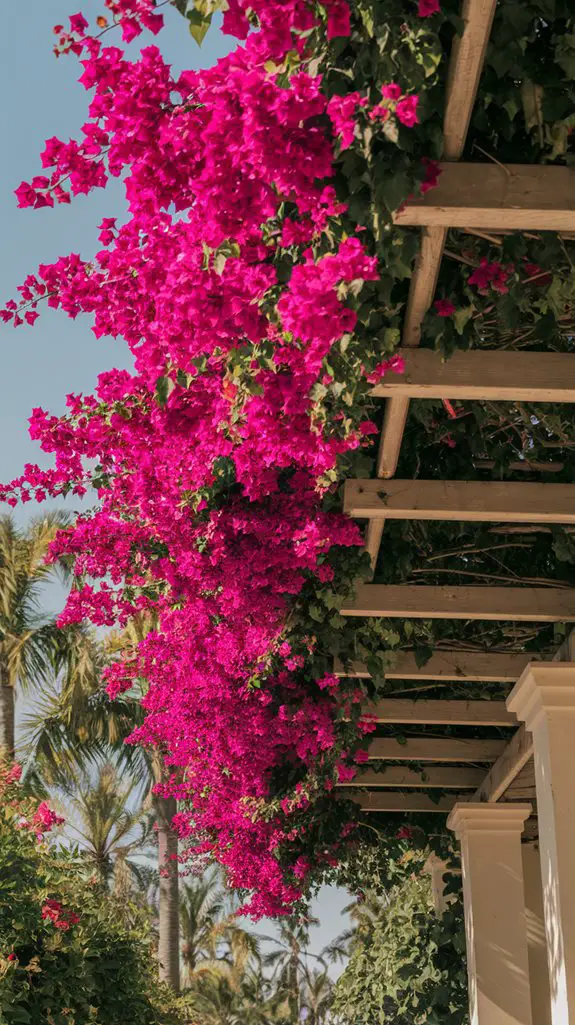
Celebrated for its vibrant paper-like bracts in shades of magenta, orange, red, and white, Bougainvillea (Bougainvillea spp.) stands as one of the most visually striking climbing plants for pergola and gazebo coverage in USDA zones 9-11.
This drought-tolerant powerhouse thrives in full sun and well-drained soil, requiring minimal irrigation once established. You'll appreciate its thorniness as a security feature, though gloves are essential during pruning.
Train young plants horizontally along supports to maximize flowering, as blooms emerge primarily from horizontal growth.
Bougainvillea's vigorous growth—up to 20 feet annually—demands twice-yearly pruning to maintain shape. For peak flowering, apply phosphorus-rich fertilizer (15-30-15) monthly during growing season.
Unlike true flowers, the colorful bracts surround small, inconspicuous white blooms, persisting up to eight weeks in favorable conditions.
Honeysuckle: Sweet-Scented Vines for Pollinators
While Bougainvillea offers bold visual impact, Honeysuckle (Lonicera spp.) attracts with its intoxicating fragrance and nectar-rich tubular flowers. This vigorous climber provides excellent coverage for pergolas while supporting essential pollinators in your garden.
You'll find numerous varieties with varying bloom colors and growth habits.
- Japanese honeysuckle (L. japonica) grows 15-30 feet with yellow-white flowers that darken to cream, blooming from late spring through summer.
- Trumpet honeysuckle (L. sempervirens) produces bright red-orange blossoms on semi-evergreen foliage, remaining compact at 10-15 feet.
- Hall's honeysuckle cultivars offer exceptional cold hardiness (USDA zones 4-9) with prolific flowering and pronounced evening fragrance.
Plant in well-draining soil with morning sun and afternoon shade for ideal performance. Additionally, this nectar-rich plant is a favorite among hummingbirds, enhancing the biodiversity of your garden.
Prune after flowering to control growth and maintain desired shape.
Morning Glory and Moonflower Combinations
For a dramatic day-to-night flowering display on your pergola or gazebo, pairing morning glories (Ipomoea purpurea) with moonflowers (Ipomoea alba) creates a synchronized succession of blooms.
These botanical cousins offer complementary flowering cycles—morning glories unfurl vibrant trumpet-shaped flowers at dawn, while moonflowers present their 6-inch white blooms at dusk.
Plant them together in well-draining soil with full to partial sun exposure. Space seeds 6 inches apart and provide sturdy trellising as both species can reach 15 feet in a single season.
You'll need to scarify moonflower seeds before planting by nicking the hard seed coat. These vigorous climbers require minimal care beyond occasional watering during dry spells.
The combination attracts diverse pollinators—hummingbirds and bees visit morning glories while sphinx moths pollinate moonflowers.
Passion Flower: Exotic Blooms for Statement Appeal
Passion flowers (Passiflora spp.) represent the perfect architectural complement to the day-night flowering cycle previously discussed.
These exotic climbers showcase intricate, otherworldly blooms that immediately draw attention to your outdoor structure. Their vigorous growth habit makes them ideal for covering pergola frameworks within a single season in zones 7-10, while some varieties offer surprising cold-hardiness down to zone 6.
- P. caerulea (Blue Passion Flower) delivers purple-tinged white flowers with prominent purple filaments, reaching heights of 30+ feet with adequate support.
- P. incarnata (Maypop) produces edible fruits following its lavender blooms and demonstrates exceptional drought tolerance once established.
- P. 'Incense' offers improved cold-hardiness (to -10°F) while maintaining the genus's characteristic complex floral structure and attractive purple coloration.
Additionally, incorporating native plants for wildlife can enhance the overall ecological value of your garden, supporting local fauna and improving biodiversity.
Best Seasonal Planters to Complement Climbing Plants
How can you enhance the visual impact of your climbing specimens while maintaining year-round interest at the base of your pergola or gazebo?
Strategic selection of seasonal planters provides multilayered visual interest and extends the flowering period of your structure.
For spring, integrate bulb compositions with narcissus, muscari, and early tulips in frost-resistant terracotta.
Shift to summer with drought-tolerant options: lavender, heuchera, and calibrachoa in glazed ceramic containers.
Autumn demands structural elements—ornamental grasses, heathers, and late-flowering sedums in weatherproof composite planters.
Winter interest comes from hellebores, silver-leaved evergreens, and winter pansies in insulated containers.
Position planters asymmetrically around support posts, using varying heights to create rhythm.
Employ self-watering reservoirs to maintain consistent soil moisture during climbing plants' establishment phase. Additionally, consider incorporating sustainable herb gardens at the base of your structure for both aesthetic appeal and culinary benefits.
Conclusion
With your pergola or gazebo adorned in these flowering climbers, you've created a modern-day hanging garden that Babylon's architects would envy. You'll maximize vertical space while surrounding yourself with precise combinations of bloom cycles, growth habits, and complementary color profiles. By strategically pairing woody perennials with annual vines, you're ensuring both immediate impact and lasting structure throughout your garden's seasonal changes.

